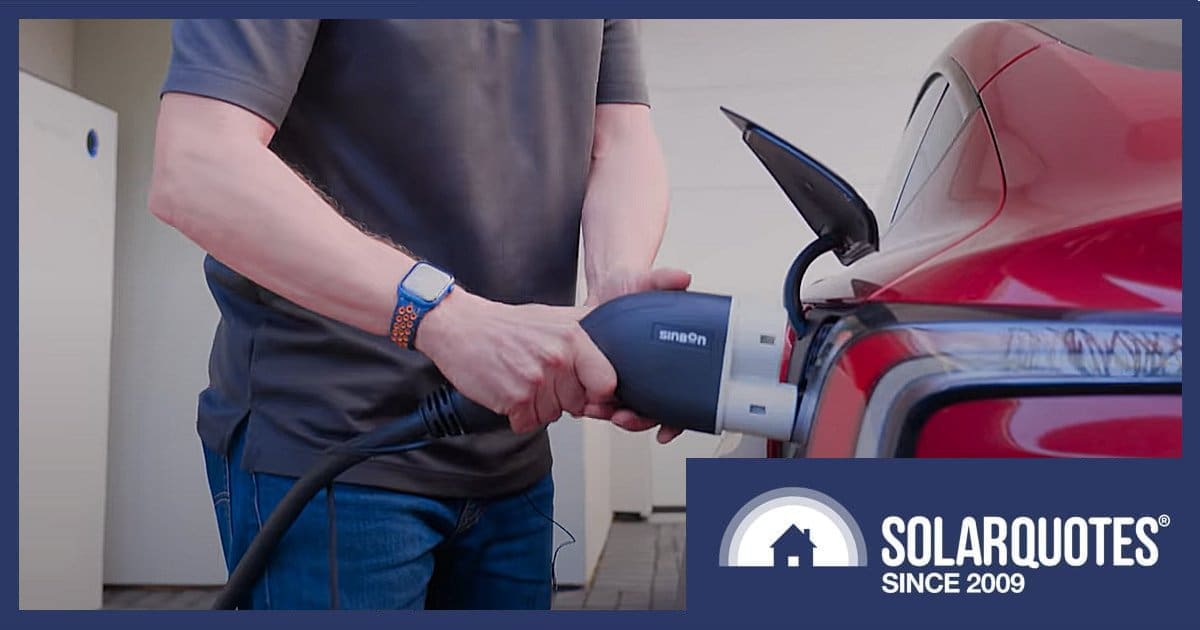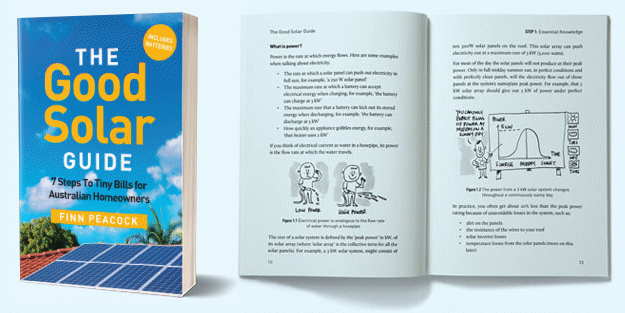
The Electric Vehicle Council (EVC) has made its case for expanding Australia’s home battery rebate program to include Vehicle-to-Grid (V2G) EV chargers.
Electric cars are essentially big batteries on wheels. For example, our BYD Atto 3 has a 60 kWh battery, which is more than 4.4 times the storage capacity of a Tesla Powerwall 3. The Atto 3 also has Vehicle-to-Load (V2L) features, meaning we can plug household appliances1 into a special adapter that connects to the charging port – our first experience with this was making an ‘Atto Espresso’.
But V2G, aka bidirectional EV charging, allows energy stored in EV batteries to be exported to the grid. Our Atto isn’t capable of this and very few EVs available in Australia are. V2G-capable chargers are also scarce and still incredibly expensive2, although pricing will drop as the tech evolves and more manufacturers get on board.
Manufacturers of bidirectional charging products have also had to battle Australia’s mish-mash of network connection policies and smart-grid integration architectures. But early this year, a National Roadmap for Bidirectional EV Charging was finally released, indicating what governments and industry need to do so EV batteries can be used to power homes and feed into the broader energy grid.
$3,000 V2G Charger Rebate Proposed
Assuming all the other ducks are lined up and to help boost uptake, the Electric Vehicle Council wants the federal government to include bidirectional chargers in its recently launched $2.3 billion home battery rebate program. The Council argues that such a rebate could provide good bang for buck.
“The modelling shows that over five years, a $3,000 government rebate towards a V2G charger would create more than $4,500 in downward pressure on electricity bills across Australia,” the organisation says. “That means for every dollar spent supporting V2G, $1.50 comes back through lower wholesale prices and a reduced need for additional capital expenditure on power infrastructure.”
In addition to the downward pressure on everyone’s electricity bills, the EVC says EV owners could earn $1,000 annually by sending energy from their cars to the grid.
“The EVC estimates that 600,000 EVs doing V2G could match the output of NSW’s Eraring power station operating at full capacity3,” states the Council. “With the federal government’s initiative, more Australians can get onto V2G quicker and we can shut down coal fired power stations sooner.”
Currently, there are around 350,000 EVs in Australia. While numbers should grow dramatically in the years ahead, not all of those owners would consider a bidirectional charger for reasons of cost (even with a rebate) or not being able to charge their EV at home for whatever reason. And some might prefer using their vehicle’s battery to supply their own home (V2H) rather than discharging it to the grid. Although that still has peak demand reduction benefits, so does installing a home battery.
The EVC’s proposal calls for the Cheaper Home Batteries program (which is uncapped) to include the rebates for 50,000 V2G chargers in homes around the country by the end of 2028. The initiative would cost $150 million, but create a national benefit of more than $230 million by 2033 the group says.
But Is V2G A Dead-End?
SolarQuotes founder Finn Peacock has previously stated he thinks V2G may be an expensive detour and a distraction; for example leading some Australians to hold off buying an EV (and missing out on savings) while waiting for something that might not eventuate in the form they want.
“… in reality, it’s all hassle, cost, and fiddliness — in exchange for pocket change and an illusion of control.”
He explains in greater detail why he currently views V2G as a furphy here. Note that the post was written just before the federal home battery rebate was originally announced.
Related: V2L, V2G, V2H, V2X …WTF?
Footnotes
- The Atto 3’s V2L has a continuous output capacity of 2.2 kW. ↩
- For example, the V2G/V2H capable module of the Sigenergy Sigenstor battery system starts at around $7,000. ↩
- Eraring has four 720 MW coal-fired units and one 42 MW diesel-fueled generator, for a total capacity of 2,922 MW. ↩

 RSS - Posts
RSS - Posts



So will i also get a similar rebate for the inverter I need that allows my static battery to provide power to the grid ?
Just another industry pressure group trying to get their snouts in to the trough.
I’m not interested in feeding the grid given current lack of incentive and self-consumption is where I am looking.
I just want to look at viability of V2H ROI as when looking at home batteries the ROI for home batteries doesn’t stack up for me yet.
It looks like there are two options coming shortly – AC bi-directional chargers (limited by car inverter, ~$2k) & DC bi-directional chargers (own inverter, ~$6k).
Looks like CEC is releasing the first batch of approved devices on 23rd August 2025, so I expect another article will follow this one 🙂
https://cleanenergycouncil.org.au/industry-programs/products-program/inverters/standards-change
The more I think about it, the more I want to see the EVC modelling.
Surely not that hard for tech to be developed so EV V2L capability can be used for V2H and V2L.
2.2kws for existing vehicles would be a good start and better than nothing, wouldn’t it?
It is. That’s what’s been available for a couple of years now, Neil.
Even my economy MG4 does around 2.5 kW V2L. Plug that into the generator input on my system, and it becomes V2H. (Or run an extension cord to the fridge with the icecream)
Mind you, 46 kWh of home batteries here, so why bother? When 50 – 100 kWh becomes average, by decade’s end, all the clumsy V2H/V2G hoo-hah will be forgotten. Just stuff photon energy in the car, and drive, fully fossil-free and climate-hell avoiding. Many do it now. We don’t drain the ICE car to put fuel in the lawnmower, so just let the house battery do the house, Simples.
It is happening faster than the 90% solar panel price decay over the last few decades. It’s just a case of “give me patience … and give it now!”, I sense.
Technerds and the affluent go first, bringing the price down for later adopters. The herd makes it in the end, saying “I thought they said this was complicated.”
Agree that V2G is a dead end.
But from the policy point of view, this will spur new EV sales (which is the Electric Vehicle Council’s ulterior motive). Nobody will be buying this for their existing EV (because aren’t many existing V2G cars out there).
It wouldn’t have enough effect on the grid to make a difference. But it probably would have some effect.
I say let them try. If anyone was holding out for an EV and this is the incentive that changes their mind, go get it. V2G won’t do what they think but it’s likely still a net positive.
I’ve been wondering if it would be possible, with suitable cables and connectors, to feed an EV battery to the solar input of an existing grid-tied solar inverter? The car battery could then be fed into the grid, as the inverter does when the sun is shining. Typical EV battery voltages range from approximately 400V to 800V, similar to many solar panel strings.
I’m not clued up enough to know exactly what might be required to make this work, but at first glance, at least it would appear to be a relatively cheap possible option for those with existing solar power systems Any thoughts?
I’m not sure V2G is a completely dead duck. We’re with Amber and last month had two days of spikes where I made $125 & $90 respectively per day exporting back to the grid. This was using a 13.5kWh Powerwall.
Admittedly there was a bit of a gamble that the forecast spikes would eventuate (buy price was higher than normal) but I estimated that I could’ve made four to five times the above amount if I had V2G capability as the spikes really went through the roof that night while my mostly fully charged EV sat in the driveway unutilised and my Powerwall was all but empty.
Spikes are fairly common but are generally much lower than the those quoted above, however making a bit of money or breaking even at worst has been achievable most of the time.
Having said all that, this could all become a moot point if the grid eventually balances out and the spikes become less frequent or non-existent. It would be nice to have the option though – just in case.